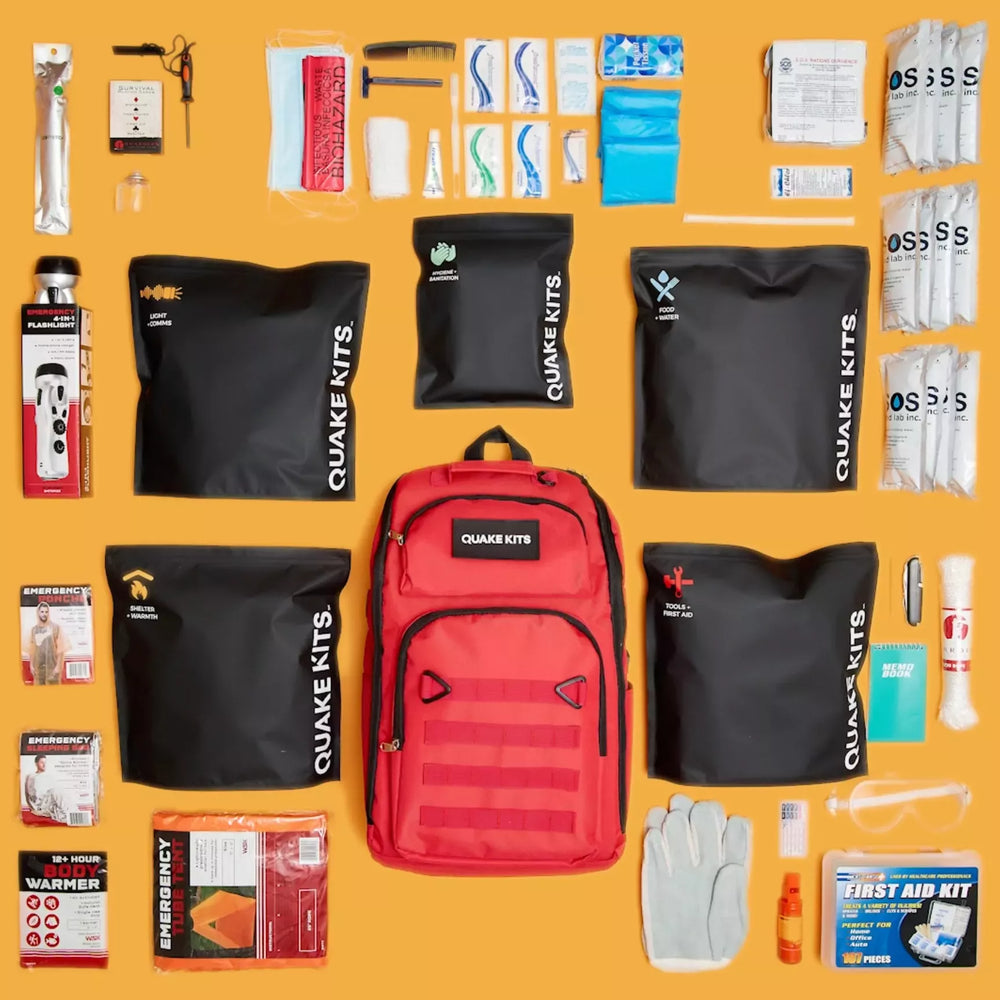How to Build a Go-Bag: Your 72-Hour Lifeline
How to Build a Go-Bag: Your 72-Hour Lifeline
When we talk about emergency preparedness, building a go-bag is one of the most important steps you can take to ensure your safety during a crisis. Whether you’re evacuating due to a natural disaster or facing an unexpected emergency, a well-prepared 72-hour kit, also known as a go-bag, can make all the difference. But what exactly should you pack, and how do you make sure you're ready for anything?
In this post, we'll walk you through how to build a 72-hour go-bag that covers all the essentials. From food and water to first aid and shelter, these are the critical items you need to stay safe, healthy, and comfortable for up to three days in an emergency.
Essential Gear for Your 72-Hour Go-Bag
When preparing a go-bag, the key is to pack items that are versatile, lightweight, and effective in various scenarios. Here’s a breakdown of the must-have gear for any 72-hour kit.
Backpack and Storage
Quake Kits Molle Backpack: Your go-bag starts with a sturdy, durable backpack. Look for one that's large enough to hold all your essentials but comfortable enough to carry for long periods. The Quake Kits Molle Backpack is rugged, weather-resistant, and designed for emergencies, making it ideal for survival situations.
Tip: Opt for a pack with multiple compartments to organize gear efficiently. That way, you can access critical items quickly when needed. All QK kits are categorized with items placed in separate content bags.
Staying Hydrated
Water Purification Straw: Having access to clean water is non-negotiable in an emergency. A water purification straw allows you to drink safely from lakes, rivers, or streams by filtering out harmful contaminants. Pack at least one for each family member.
Tip: Carry enough bottled water for at least three days—1 gallon per person, per day. The purification straw is a backup in case your water supply runs out.
Keeping Warm and Dry
Mylar Blanket: These compact, reflective blankets trap body heat and are essential for cold weather. They’re lightweight, waterproof, and can also be used as a rain shelter or ground cover.
Tip: Pack a few extra mylar blankets for layering or emergency use with pets.
Food and Cooking Supplies
Portable Stove: A small, portable stove is crucial for preparing hot meals and boiling water. In a 72-hour situation, it’s not just about survival but also maintaining morale. Eating hot food can be a major comfort during stressful times.
Survival Food: Freeze-dried meals and high-calorie emergency rations are easy to pack and don’t require much preparation. Choose meals that are nutrient-dense and require only water to prepare.
Tip: Don't forget to pack utensils, matches, or a fire starter. Include lightweight cooking pots if your portable stove needs them.
First Aid Kit
Basic First Aid Kit: Your go-bag should include a well-stocked first aid kit with items like bandages, antiseptic wipes, tweezers, gauze, and medical tape. Be sure to include any prescription medications you or your family may need, along with over-the-counter pain relievers.
Tip: Consider adding extra items like a tourniquet, burn cream, and emergency medical guidebook for more serious injuries.
Navigating Your Way
Compass and Map: If cell phone service is down, you’ll need a backup way to navigate. A basic compass and local map can help you find your way to safety if you're disoriented.
Tip: Practice reading a map and using a compass before an emergency arises, so you're confident using them in a crisis.
Warmth and Shelter
Tube Tent: A lightweight tube tent provides quick shelter from the elements. It’s easy to set up and can protect you from rain, wind, and cold, making it an essential item for your go-bag.
Tip: Include extra paracord or bungee cords to help secure the tent and create more versatile shelter options.
Staying Safe and Visible
Multi-Tool: A compact multi-tool can handle a variety of tasks, from cutting rope to opening cans. Look for one that includes a knife, pliers, and screwdrivers, so you’re ready for anything.
Headlamp or Flashlight: Being able to see in the dark is crucial during an emergency. A good headlamp or flashlight with extra batteries will allow you to move safely after dark. We recommend also having a dynamo powered flashlight on hand in case your batteries die.
Tip: Pack spare batteries and consider including a small solar charger for recharging other essential devices like your phone or radio.
Hygiene and Sanitation
Personal Hygiene Kit: Maintaining basic hygiene is important even in a crisis. Pack items like toothbrushes, toothpaste, hand sanitizer, soap, wet wipes, and toilet paper. A small travel towel can also be useful.
Tip: Consider adding a pack of biohazard bags or portable toilet options if you expect to be in a situation without access to restroom facilities.
Communication and Information
Emergency Radio: An emergency radio that runs on batteries or solar power is vital for staying informed during an emergency.
Tip: Some emergency radios also have built-in phone chargers (sort of like our 4-in-1 radio "hint, hint")—an extra benefit in a crisis.
Conclusion
Building a 72-hour go-bag doesn’t have to be overwhelming, but it does require careful planning. By ensuring you have the right balance of food, water, shelter, and safety gear, you’ll be prepared to face the unexpected.
Although making ready-to-go 72-hour kits is our bread and butter here at Quake Kits, we understand that some people prefer to build their own—and we are here to help. By following this guide and including the right essentials, you’ll be ready to respond quickly and confidently in an emergency. Remember, preparedness is peace of mind, and your 72-hour go-bag is your lifeline when it matters most.






Leave a comment